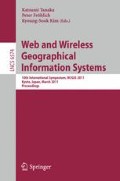Abstract
The research presented in this paper introduces a mobile assistant to spatially locate and orient passengers of a Metrobus system in the city of Mexico. The system assists blind passengers or passengers with limited eyesight. While most of the navigation systems developed so far for blind people employ a complex conjunction of positioning systems, video cameras, location-based and image processing algorithms, we developed an affordable and low-cost combination of mobile phone, GPS and compass device to provide the same range of functionalities. The mobile application is developed on top of a 3rd generation cell phone extended by GPS and digital compass devices. Interaction among these devices is achieved by using Bluetooth communications. Audible user-oriented interfaces indicate to a given user her/his location within the Metrobus system, i.e., appropriate instructions of orientation that lead to the boarding gates in that station, thanks to an orientation algorithm developed for this aim. The experiments have been performed on a Nokia N73 cell phone in a Metrobus line of the city of Mexico and validated by a panel of blind users.
Access this chapter
Tax calculation will be finalised at checkout
Purchases are for personal use only
Preview
Unable to display preview. Download preview PDF.
References
Darvishy, A., Hutter, H.-P., Früh, P., Horvath, A., Berner, D.: Personal mobile assistant for air passengers with disabilities (PMA). In: Motion, - Working Papers in Transportation Systems. School of Engineering, vol. 2. ZAW, Winterthur (2008)
http://www.datasheetcatalog.net (last access October 2008)
Dybkjaer, L., Hemsen, H., Minker, W.: Evaluation of Text and Speech Systems. Text, Speech and Language Technology Series, vol. 37. Springer, Heidelberg (2008)
Golledge, R.G., Stimson, R.J.: Spatial Behaviour: a Geographic Perspective. The Guilford Press, New York (1997)
Heuten, W., Henze, N., Boll, S., Pielot, M.: Tactile wayfinder: a non-visual support system for wayfinding. In: Proceedings of the 5th Nordic Conference on Human-Computer Interaction: Building Bridges (NordiCHI 2008), Lund, Sweden, vol. 358, pp. 172–181. ACM Press, New York (2008)
Hub, A., Diepstraten, J., Ertl, T.: Design and development of an indoor navigation and object identification system for the blind. In: Proceedings of the 6th International ACM SIGACCESS Conference on Computers and Accessibility, Assets 2004, Atlanta, GA, USA, October 18-20, pp. 147–152. ACM, New York (2004)
Hub, A., Hartter, T., Ertl, T.: Interactive tracking of movable objects for the blind on the basis of environment models and perception-oriented object recognition methods. In: Proceedings of the ACM SIGACCESS Conference on Computers and Accessibility, Portland, Oregon, USA, pp. 111–118 (2006)
http://www.inegi.org.mx/lib/buscador/ (last access: December 2008)
Jacobson, D.: Cognitive mapping without sight: four preliminary studies of spatial learning. Journal of Environment Psychology 18, 189–305 (1998)
Jacobson, D.: Representing spatial information through multimodal interfaces: overview and preliminary results in non-visual interfaces. In: Proceedings of the 6th International Conference on Information Visualisation, pp. 730–734. IEEE Press, Los Alamitos (2002)
Kitchin, R., Blades, M., Golledge, R.G.: Understanding spatial concepts at the regional scale without the use of vision. Progress in Human Geography 21(2), 225–242 (1997)
Klatzy, R.L., Lippa, Y., Loomis, J.M., Golledge, R.G.: Encoding, learning and spatial learning of multiple object locations specified by 3D sound, spatial language and vision. Experimental Brain Research 149, 48–61 (2003)
Na, J.: The blind interactive guide system using RFID-based indoor positioning System. In: Miesenberger, K., Klaus, J., Zagler, W.L., Karshmer, A.I. (eds.) ICCHP 2006. LNCS, vol. 4061, pp. 1298–1305. Springer, Heidelberg (2006)
Rehrl, K., Bruntsch, S., Mentz, H.J.: Assisting multimodal travelers; design and prototypical implementation of personal travel companion. IEEE Transactions on Intelligent Transportation Systems 8(1), 31–42 (2007)
Rice, M., Jacobson, D., Golledge, R.G., Jones, D.: Considerations for haptic and auditory map interfaces. Cartography and Geographical Information Science 32(4) (2005)
Shinohara, K.: Designing assistive technology for blind users. In: Proceedings of the 8th International ACM SIGACCESS Conference on Computers and Accessibility, Assets 2006, Portland, Oregon, USA, October 23-25, pp. 293–294. ACM Press, New York (2006)
Virtanen, A., Koskinen, S.: Navigation System for the Visually Impaired based on Information Server Concept, VTT Technical Research Center (2010), http://virtual.vtt.fi/noppa/materiaali.htm (last access: October 2010)
Vollmer, J.: PAVIP-Feldversuch in Bern. SZB-Information, Fachzeitschrift für Sehbehindertenwesen 133, 45–46 (2004)
Willis, S., Helal, S.: RFID information grid and wearable computing solution to the problem of wayfinding for the blind user in a campus environment. In: Proceedings of the 9th IEEE International Conference on Wearable Computers, pp. 34–37. IEEE Press, Los Alamitos (2005)
Author information
Authors and Affiliations
Editor information
Editors and Affiliations
Rights and permissions
Copyright information
© 2011 Springer-Verlag Berlin Heidelberg
About this paper
Cite this paper
Mata, F., Jaramillo, A., Claramunt, C. (2011). A Mobile Navigation and Orientation System for Blind Users in a Metrobus Environment. In: Tanaka, K., Fröhlich, P., Kim, KS. (eds) Web and Wireless Geographical Information Systems. W2GIS 2011. Lecture Notes in Computer Science, vol 6574. Springer, Berlin, Heidelberg. https://doi.org/10.1007/978-3-642-19173-2_9
Download citation
DOI: https://doi.org/10.1007/978-3-642-19173-2_9
Publisher Name: Springer, Berlin, Heidelberg
Print ISBN: 978-3-642-19172-5
Online ISBN: 978-3-642-19173-2
eBook Packages: Computer ScienceComputer Science (R0)

